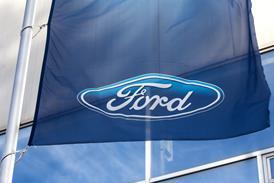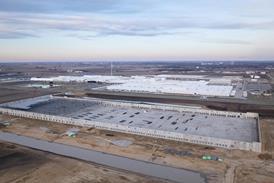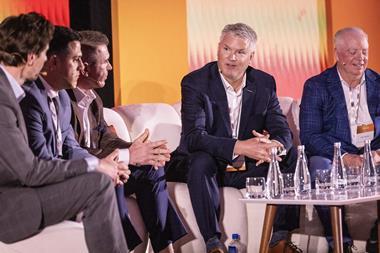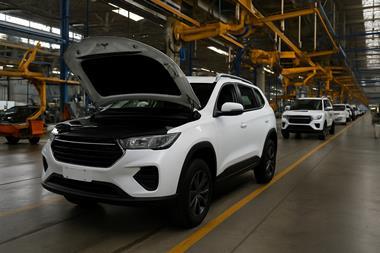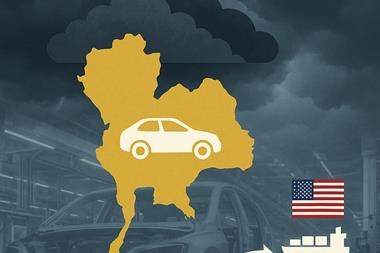
In theory, Kaluga should not work as an automotive cluster. It is under-developed, fairly remote and there is a limited labour base. But the attitude adopted by the local authorities and innovative logistics are winning carmakers over
Russia was, for a moment, Europe’s largest car market. It may well be again, but the production base of the country is a different prospect.
Foreign OEM factories in Russia began with just tentative bridgeheads usually with CKD assembly operations; but manufacturers have found their operations so successful that they moved rapidly to fully builtup operations. Yet these plants have one thing in common: they are based in or around St Petersburg. The dominant reason for this is logistics: St Petersburg is a short distance from the efficient ports of Finland and their supporting shipping services from Western Europe.
Yet Volkswagen and PSA Peugeot-Citroen, in joint venture with Mitsubishi, along with Volvo Trucks opened their plants in Kaluga. Why Kaluga? A city 150km southwest of Moscow, it at first appears an unlikely place for a cluster of plants.
Production out of the plants is small and either semiknockdown (SKD) or complete-knockdown (CKD). VW opened its plant in 2007, producing the Polo. It moved from SKD to CKD in 2009, producing the Tiguan and the Skoda Octavia. The plant has a capacity to produce 150,000 vehicles a year, and although is still a CKD plant, it is reasonably advanced for such operations. The plant has its own paintshop, for example.
The Peugeot-Citroen Mitsubishi facility is even newer. Again a SKD facility, it is designed to move to being CKD in 2012 and expand its production from 90,000 to 120,000 of the Peugeot 308/Citroen C4 and Peugeot 4007/Citroën C-Crosser/ Mitsubishi Outlander. The third plant is a truck plant built by Volvo Trucks with volumes of around 15,000 vehicles per year. There are also a string of tier one suppliers in Kaluga, largely located in a dedicated supplier park in the city. And perhaps surprisingly, the region appears to have increasing potential to emerge as a larger production hub.
By western European standards Kaluga is remote. Moscow can be reached in a day and there are some people that commute to the Moscow region from there. But in comparison to St Petersburg, it is much more difficult to get components and products into and around Kaluga. Yet logistics managers working in Kaluga assert that the city has big advantages over St Petersburg.
Gefco has a big presence in the city, supporting both the Peugeot-Citroen/Mitsubishi joint venture and other vehicle manufacturers. Christian Zbylut comments: “The Kaluga location is showing big advantages over other locations from a logistics point of view. St Petersburg has seen a large number of OEMs moving to St Petersburg to start production of cars there. Now there are a huge number of cars being produced at St Petersburg and as a result you have a lot of empty trucks… as a result the logistics costs of supplying Moscow from St Petersburg are increasing dramatically.”
Russian geography resembles that of North America, but without the infrastructure. The favoured transport mode for the European automotive sector is usually road freight and this is the solution that Volvo Trucks has largely taken. Components are consolidated in both Sweden and near its large plant in Belgium. These are then moved by truck through Central Europe, into Russia and onto Kaluga. Volvo Logistics’ Mike Medden admits that there are occasionally problems with interruptions on the routes, citing the present problems on the Polish-Belorussian border as an example. However, he observes that road transport gives you the option to be flexible, routing traffic around problems, although he also comments that he is also open to rail or air solutions if they work.
Gefco has chosen a different configuration for supporting the PSA-Mitsubishi joint venture. As Christian Zbylut describes, Gefco uses rail with SKD kits being containerised and shipped to the Polish border where they are transferred to Russian gauge trains and taken on to Kaluga. “The process is very smooth and has proven to be the most reliable route to support production in Russia”. Volkswagen uses similar intermodal solutions provided by DB Schenker, connecting Kaluga with suppliers in central Europe and Germany.
Although a number of other logistics service providers remain sceptical over the viability of rail as a major freight transport resource in Russia, it may have advantages. If Gefco and Schenker have been successful in creating a viable rail based supply network in Kaluga it may well prove an important asset in facilitating the scaling-up of automotive production in the city.
 Overwhelmingly the Kaluga facilities rely on component flows from Western Europe to support their operations. Yet this is not a viable option in the long-term if Russia is to expand its automotive production base. For example, tier supplier Visteon, which has a facility in the Kaluga supplier park and provides interiors for Volkswagen, has a long-term objective of sourcing supplies from within Russia. Business unit manager Jens Trabert makes the point that localisation is imperative, “To localise is mandatory to survive in Russia.”
Overwhelmingly the Kaluga facilities rely on component flows from Western Europe to support their operations. Yet this is not a viable option in the long-term if Russia is to expand its automotive production base. For example, tier supplier Visteon, which has a facility in the Kaluga supplier park and provides interiors for Volkswagen, has a long-term objective of sourcing supplies from within Russia. Business unit manager Jens Trabert makes the point that localisation is imperative, “To localise is mandatory to survive in Russia.”
He makes the point that the logistics problems, the tariffs on imported components and the related customs fees and the need in the long-term to support fully built-up production makes the localisation of the supply chain an imperative. The length of supply chain makes inventory management difficult and production systems such as JIS/JIT impossible. The whole scheduling and production logistics environment is quite unstable, with frequent changes in the level of output by the assembly plants.
As ever in Russia infrastructure is an issue and progress has not always been smooth. Despite the aggressive support of the political authorities, the provision of dedicated infrastructure such as supplier parks has not been easy. Kaluga has built a substantial supplier and logistics park next to the VW facility, however the construction of what normally would be a private sector project was badly disrupted by the recession and the financial problems of a number of companies involved. In the end the European Bank of Reconstruction and Development stepped in to finance the project, illustrating that the resources to get things done are there in Kaluga.

And there are other issues facing Kaluga. Although the area was initially impoverished with little real development, the influx of vehicle manufacturers has had a big impact on the labour market. There is now a shortage of skilled labour in the region, although again the authorities have responded by helping to create technical colleges and courses to meet this demand. More difficult is the issue of attracting managers to what is a fairly isolated area.
Roads are still poor. Christian Zbylut observes that it takes two-and-a-half hours to drive into the capital despite the journey being just 150km. Volvo Logistics’ Mike Medden confirms this: “The roads aren’t brilliant…but I have been in Kaluga for three-and-a half years, and two years ago Putin promised to spend 400 billion rubles ($14 billion) on infrastructure and from where I am sitting he’s doing it. It’s not perfect and it’s got a long way to go but it’s like building a house, you start with the foundations.”

An illustration of the issue of both the difficulties of doing logistics in Russia and of how to surmount them is the issue of customs. As Visteon points out, each load of components imported into Russia is subject to a tariff and the paperwork for this can be onerous. Therefore it makes sense to consolidate loads before entering the country.
To tackle what was a significant obstacle to the efficient working of all of the plants, Volvo, VW and Peugeot-Citroen/ Mitsubishi persuaded the customs authorities to establish customs posts within each of their assembly plants. This reduces lead times and injects transparency into the system. It is also a strong example of why Kaluga is attractive to vehicle manufacturers. In Kaluga the authorities are willing to work with the automotive sector. However, as Jens Trabert observes: “You must leave behind the attitudes of Western Europe and realise that you are working in a different culture.”
In Kaluga creating an effective working environment is possible. As Volvo’s Medden comments, “For getting on in Russia there is one simple rule. Involve and embrace the authorities, do not be scared of them.”
These issues get to the heart of why Kaluga has emerged as an automotive production cluster. The drive to attract big vehicle manufacturers is essentially political. The regional political leadership in Kaluga were desperate to deal with the problems of an impoverished and neglected part of Russia. In doing so they were able to gain the support of Moscow, both in terms of attracting state funds and having influence over the rest of the state bureaucracy–such as the customs authorities.
DHL Supply Chain’s Nore Kamoun makes the powerful observation that the growth of Kaluga, “implies that there is a track-record of burnt fingers,” amongst OEMs. He notes that the problems of getting projects delivered on-time and the ability to sustain a dialogue with the local authorities and to have them deliver the surrounding network of infrastructure: “Simple things such as entry and exit roads or electricity,” are what gives Kaluga a solid platform for expansion in the automotive sector.
The problem for Russia is that this is not the norm. Too often authorities are not merely unhelpful but are even hostile to investments they feel they have no control over. The impact of this is that decisions about production locations are being settled by non-logistics issues. The perspective of those based in St Petersburg is that under normal conditions the decision to locate major production facilities in a location as small as Kaluga would not make sense. It is a symptom of the condition of the Russian economy and the Russian state.
The success of Kaluga only highlights the issues for the rest of Russia and the challenges that the automotive sector will face if it is to expand production in the country. DHL’s Nore Kamoun asserts: “This is linked to the new agenda for Russia. The state needs to be capable of providing infrastructure and logistics is one of the most important areas for this. Really this development represents the next wave for Russia.”










